Email Marketing Essentials
The Definitive Guide to Hotel Email Marketing
Use this ultimate email marketing guide if you want to:
- Grow your email list
- Boost open rates
- Write amazing emails
- Create a newsletter people read
- Transform subscribers into customers
Sound good? Then you’ll love this ultimate guide.
Let’s get to it like there’s nothing to it.
Chapter 1: Email Marketing Basics
In this section, we’ll cover the basics of email marketing.
Including what it is (why it’s so powerful) and why you need to implement it effectively.
I’ll also cover how email marketing can grow your business’s bottom line.
Email Marketing Defined
Email marketing is the digital marketing strategy of directly reaching leads, customers, and clients (using first-party data) through email. The most popular forms of email marketing messages are newsletters, receipts, transactions, and promotions. Email marketing, when used properly, has the highest ROI of other digital marketing methods (like Google Ads or Social Media).
The reason email is so effective is that it enables you to communicate directly with leads, customers, and subscribers (cost-effectively). It is a one-to-one connection that allows you, for example, to leverage a single personalized message into many. Email marketing is cost-effective, able to be automated, and provides immediate follow-up with leads and customers.

With endless options and cool new platforms, like Snapchat and Tik Tok, is email marketing still an effective way to market your business?
Let’s find out…
Will Email Marketing Work in 2021?
I won’t geek out too much, promise.
Here are some verified stats that support why email is still a powerful digital marketing tool (if not the most powerful and/or profitable)

The average ROI on email marketing is 44:1 (Campaign Monitor)
It will come as no surprise that (nearly) nine out of every ten marketers use email marketing to distribute their content — with the official number coming in at 87% of marketers (oberlo.com)

It’s not only marketers using email. It turns out everyone (just about) uses email, that’s probably one of the reasons it is so profitable. Among professionals, 52% responded that email is their company’s primary communication tool, with face-to-face meetings coming in a distant second. (Adobe)

Email marketing is used for a wide variety of reasons, for B2B and Organizations, 85% use email marketing for lead generation, 84% for sales, 78% for lead nurturing, and 74% for customer retention. (Content Marketing Institute)

Why Email Marketing Still Works in 2023
So, why does email marketing work incredibly well?
#1: With Email Marketing, You Control and Own The Communication.
This is huge.
When you gather an email for your list, you now have a straight line to that person’s inbox. You can email them what you want, when you want to.
Can you think of other platforms that allow this level of ownership for marketers? Facebook, TikTok, and Instagram all leave a lot to be desired when it comes to ownership.
Not only that, Facebook’s organic reach for pages is only 5.2%. (AdEspresso).
Each year, organic reach falls for Facebook, making it more expensive for marketers to reach their target audiences (or even their followers). In 2019 Facebook’s organic reach was 5.5% and the year before that it was 7.7%.
Unfortunately, it gets worse. Organic post engagement came in at 0.25% in 2020 (and 0.08% for pages with more than 100,000 followers). (Hootsuite)
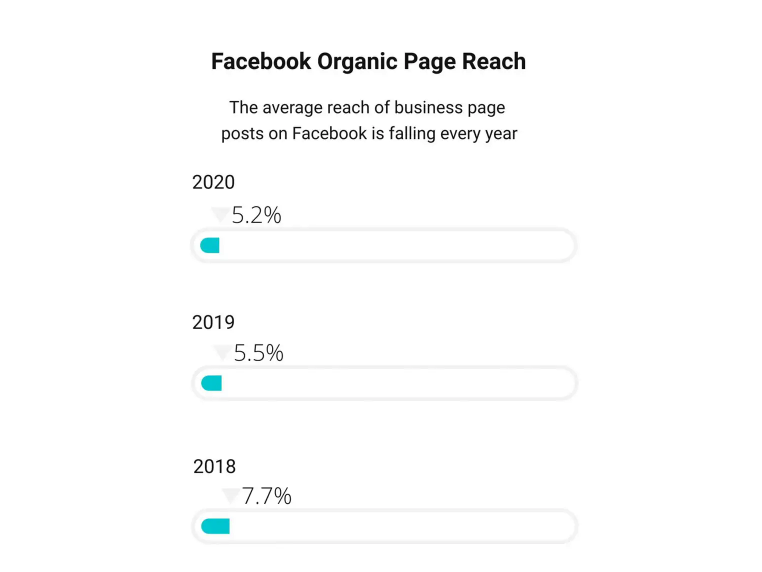
Now, let’s compare that with what you get from email marketing.
The average email newsletter open rate is 18.0%. The average click-to-open rate is 14.1%. That’s almost 20x the engagement you’d get on social media. (Campaign Monitor)

#2: Unlike Social Media People Actually WANT Email Marketing Messages
When was the last time you went on social media to see an ad or find an offer? Never.
According to Hubspot, 91% of people find ads more intrusive compared to two or three years ago, and 79% believe they’re being tracked. (Hubspot)

That’s good news for email marketers. It turns out people expect marketing messages in their email. In fact, 65% of users check their email three times a day and 44% of users check their email for deals from brands. (99firms)
It’s not just that. Email marketing generates the most neutral responses from consumers. Meaning, they’re not annoyed or thrilled by email marketing. Neutral sentiment is a goal for marketers that aims to avoid oversaturating consumers, repelling brand adopters, and increasing marketing ROI. (Hubspot)
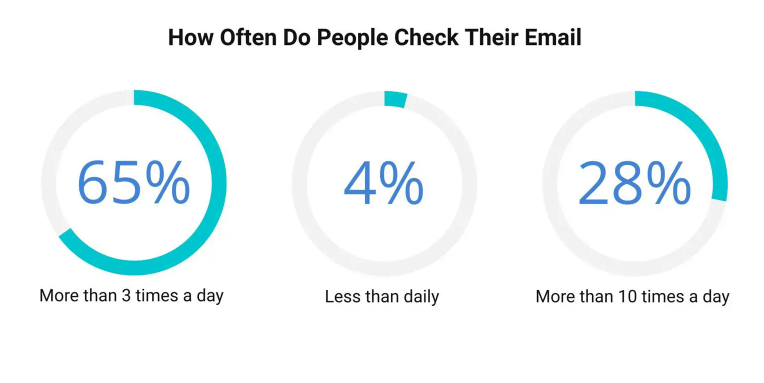
Email marketing doesn’t seem to bother people much, if at all…

#3: Email has a SUPER high conversion rate
We’ve talked about reach and engagement. But does email deliver anything to the bottom line?
Yes!
For marketers, turning leads into customers is critical, and nothing is better than email for getting the job done.

Email converts up to 40x more than Facebook AND Twitter together. When it comes to turning leads into customers, email marketing, is your best bet. (McKinsey)

Now, let’s see how to build and grow a profitable email list.
Let’s get to it!
Chapter 2: How to Build an Email List
In order to take advantage of the stats we’ve covered you need to build an email list.
In this chapter, I’ll show you exactly how you can build your email marketing list using proven and profitable strategies.
These are the exact strategies we’ve used to grow our email list from scratch. We’ve sent over 1,000,000 emails this year.
Now it’s your turn to get started.
Let’s go!
Optimizing Your Homepage for Conversions
For websites, the most visited page will be your homepage (and your about page but we’ll get to that next).
Your homepage is your first opportunity (usually) to convert website visitors.
It can be, and usually is, the first stop on a visitor’s journey to becoming a subscriber.
I recommend putting a strong, clear, and concise call-to-action (CTA) on your homepage, like our friends at Digital Marketer have done on their homepage.

Our homepage features a clear call to action that triggers our scheduling bot…

A homepage optimized for email conversion, with a clear Call-to-Action, will naturally grow your email list.
Here’s one more example from Drift.

The advantage is obvious. Homepages optimized for email lead generation get more emails.

Speaking of important pages, your “About” page is probably ripe for improvement.
Let’s get to it.
How to Improve Your About Page
Generally, your about page will be one of the highest viewed pages on your website.
It’s also one of the most under-optimized.
Psychologically, once a visitor hits your “about page” they’re invested and interested.
Put at least one sign-up form for email on the about page to get more leads.
Here’s a great example from CopyBlogger.com:
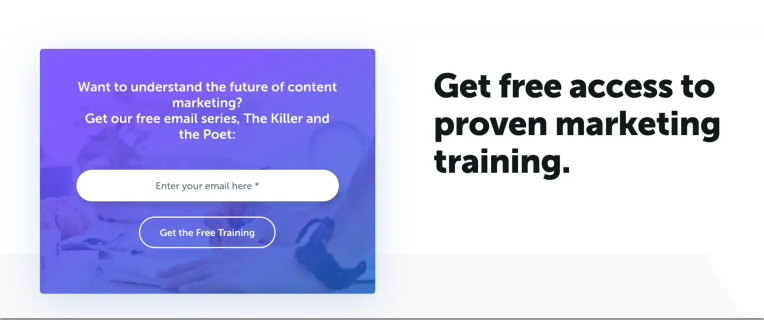
What else can we do?
On the CopyBlogger.com “About” page you’ll also notice that they’ve internally linked some of their content.
Encouraging visitors to go deeper into the site.
Like this…

Your about page is a high intent page. Treat it like everyone that visits that page is a warm lead (or could be in the future with the right offer or value proposition).

This leads to my next section.
The mack daddy of email lead generation tools.
Drumroll please, and let’s give it up for the friend of every digital marketer and creator…
The lead magnet.
Create High-Value Lead Magnets
What is a lead magnet?
A lead magnet is a HIGH quality piece of content, on a landing page, that is designed to do two things: (Bossitude)
1) Establish your expertise and authority in the mind of your prospect.
2) Generate quality leads for your business.
Here’s an example from our site of a high converting lead magnet:

Here’s a lead magnet example from Marapost…

Our friends at Hubspot have some great lead magnets like this one.

When you click the Call-to-Action (CTA) “Download Now for Free” this form (below) pops up to collect the lead’s information.

Lead magnets are an AWESOME way to grow your email list.
They’re effective, cheap to make and easy to promote.

Beacon.by has some great templates to start with like these.
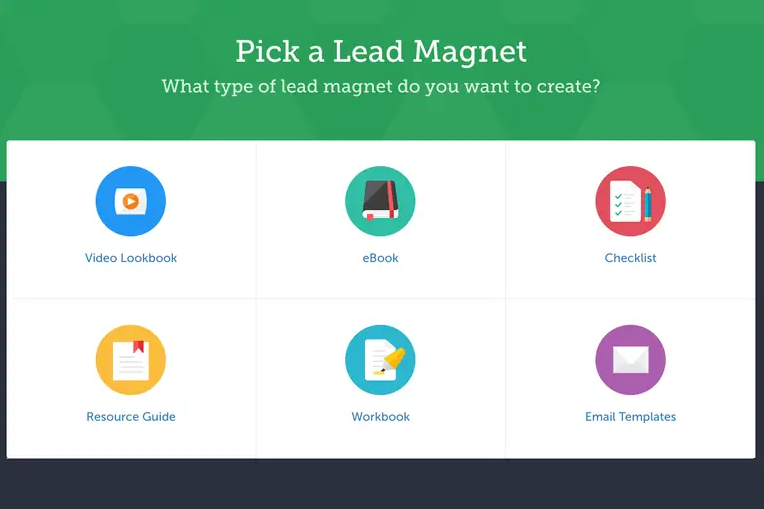
Before I get to the next section lets cover the basics on lead magnets and the path to conversion (Hubspot)
Let’s quickly review the conversion path that turns website visitors into leads — and the role email marketing plays in this process (we will cover each in the following chapters):
The first stop is the Call-to-Action
Call to Action (CTA): This is the button that blog readers and website visitors click to access the resource you’re offering through this lead magnet. They could also come from a social media post, paid ad, or other sources.
The call to action leads me to the landing page.
Landing Page: This is where your lead magnet captures information provided by the visitor. After visitors click the CTA, they’re brought to a landing page where they’ll fill out a form with their name, email address, and any other relevant information you’ve deemed important.
Here’s an example of a lead magnet and landing page with a call to action (Digital CEO Dashboard) from BusinessByDesign. I click the button on the landing page and fill out the form (form not shown). Here’s what that process looks like.

After I click the CTA and complete the form it’s on to the next stop…
The Thank You Page: The visitor is then led to a page where they can download your resource, officially adding them to your mailing list.
And here is their “Thank You” page.

Kickback Email: The kickback email is your follow-up message to the lead a short time after the exchange takes place. This email marketing campaign starts a conversation with the lead to keep them engaged with your business.
Finally, here is the kickback email I received after opting in.

Lead magnets come in many forms.
Commonly they’re in PDF format. Which is good news for everyone.
PDFs are easy to make, allowing marketers, creators, and businesses of all sizes the opportunity to get more email subscribers with lead magnets.
Lead magnets can be:
- Checklists
- Templates
- eBooks
- Guides
- Mini-Courses
- Swipe Files
- Scripts
- Resource Lists
- Printables
- Calendars
- and more

To promote your lead magnet you’ll need a place for it to live…
Ready to learn about landing pages?
Great…
Create Landing Pages
We need a place for our lead magnet to live.
Landing pages can be the perfect home. Another option is using squeeze pages (which I’ll cover)
What’s a landing page?
Landing pages are tailored, single-focused marketing pages with limited navigation aimed at converting visitors into subscribers or subscribers into purchasers. In a nutshell, they turn traffic into subscribers.
Here’s an example from our site.

See how I’ve kept the navigation limited and made the form and/or CTA visible above the fold.
Here’s another example from our friends at Hubspot.

Visitors know what to do the second they hit the page (above).
Even the best pilots use a checklist before take-off. Checklists like this one from Digital Marketer are useful.

Pro Tip: Use a landing page audit to get the best results (above).
You might be wondering…
What’s the difference between a Squeeze Page and a Landing Page?
Here’s the difference (Unbounce)

Here’s an example of a squeeze page from Problogger

It’s a little plain but it gets the job done.
Here’s another, more engaging, squeeze page from Digital Marketer.
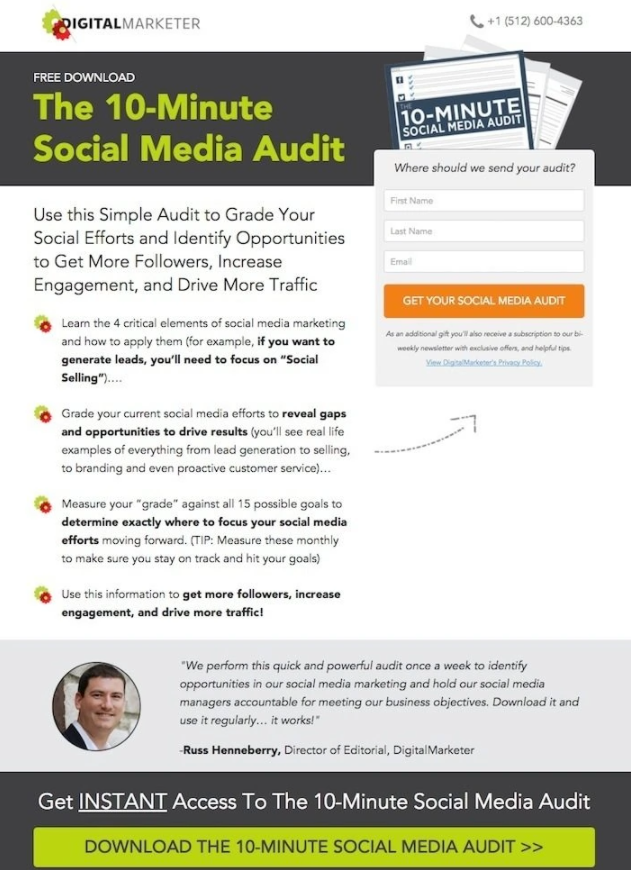
I like this squeeze page from instapage.

For good measure here is one more example from Beacon.by

Can My Homepage be a Landing Page?
I get asked if a homepage can be a short form squeeze page or a landing page?
Yes! Of course.
This can work for any business. It’s especially effective for SaaS companies.
Take a look at HelloBar’s homepage.

It’s a squeeze page. Awesome.
Then, when I go to leave the page this popup appears.

Naturally, this leads to our next section.
Exit-intent popups. Love ’em or hate ’em we’re diving in.
Exit-Intent Popups
As marketers we’ll admit it:
We LOVE popups.
That doesn’t mean everyone else does. In fact a lot of people claim they HATE them.
Let’s see what the numbers say.

This (above) exit-intent pop-up we did with GrubHub converted at 36.19% generating 36,605 leads.
In fact, using popups increases subscriptions by 1,375% (Aweber).

Pop-ups helped Entrepreneur.com increase subscribers by 86% and sales by 162% (Entrepreneur) With the average top ten percent of pop-ups converting at 9.28% (Sumo)
I’ll show you a quick example of how these work. (below)

As the user moves to exit the popup is triggered.
Here’s an example from our site of an exit-intent popup that converts well.

Exit-intent popups work.

Exit-intent popups don’t get in the way of content and improve conversion.
What’s not to love?
Use Locked Content
Locked content is one of our favorite ways to list build.
Here’s an example from our site.
I’ve re-used our lead magnet (from above) to create unlockable content.

It’s like an upgraded squeeze page.
Another way to use this tactic is with Native Ads to create content upgrade offers.
Like this one from my Hotel Headline Formulas article.

Offer the next logical step to your visitors.
If they’re reading our headline formulas article they’ll likely want the full eBook.

Extend a website visitor’s stay with useful content unlocks and upgrades.
That’s it.
Use Chatbots to Build Your Email List
Conversational marketing converts better.
In fact, 90% of consumers want to use chat to communicate with businesses (Twilio)
Chatbots and notifications are also a great way to gather leads.
Like this one from Drift.
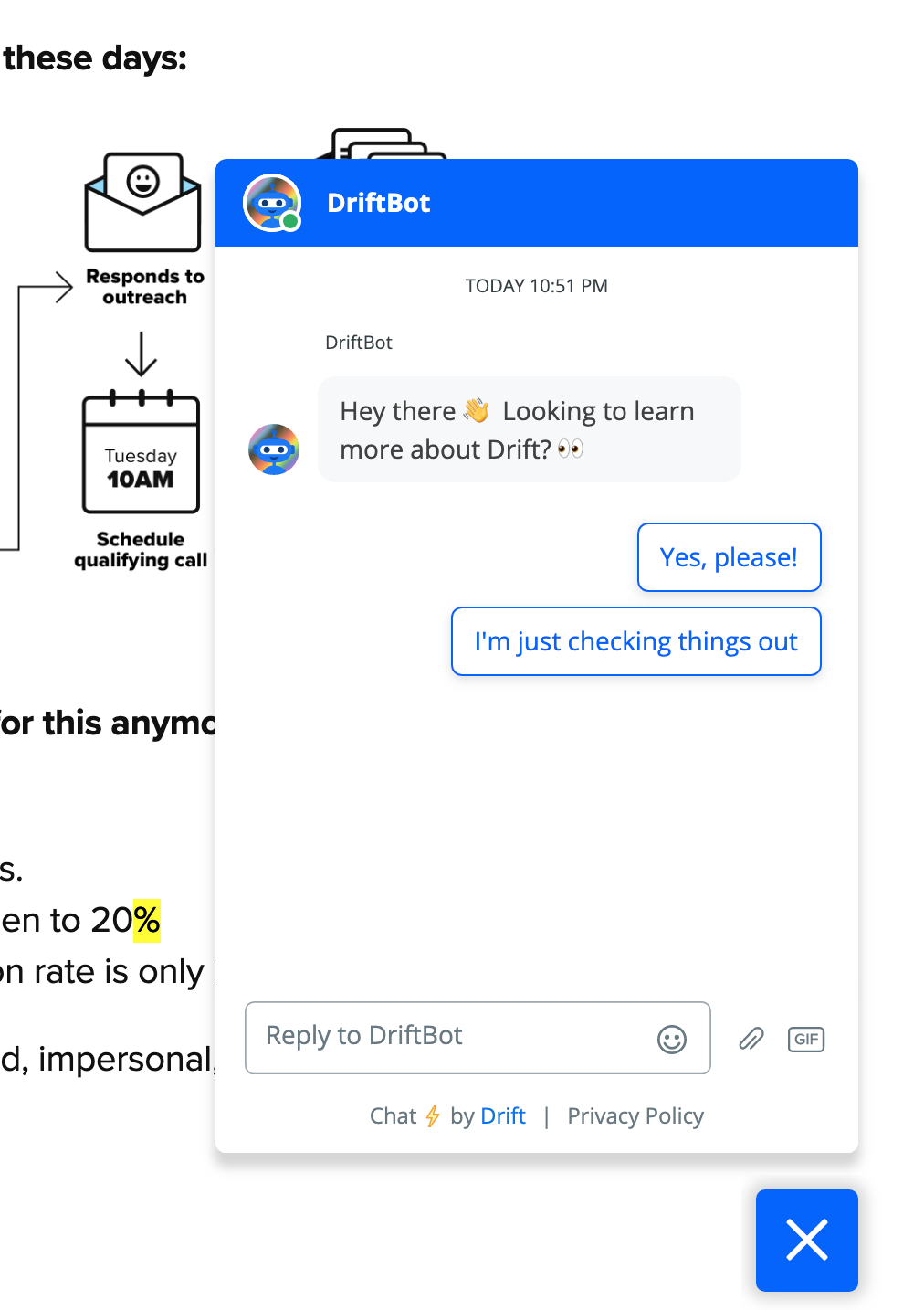
Chances are you’ve engaged with a chatbot.
In fact, 45.9% of businesses are now using chatbots to serve site visitors and generate leads (Hubspot)

Instead of a boring signup form, Drift uses engaging, page-specific chats like this one.

As you can see there’s a lot less friction in the signup process (above). It flows naturally, conversationally, and can generate a ton of email marketing leads when used responsibly.
To get the most value from bots use personalization and tailored messages with specific placements on your website.
Here are a few good places to get started.

Chat is a good way to communicate with site visitors and gather email leads.

To use these growth strategies we need to send the right emails, to the right people at the right time.
Let’s see how to do it.
Use this ultimate email marketing guide if you want to:
- Grow your email list
- Boost open rates
- Write amazing emails
- Create a newsletter people read
- Transform subscribers into customers
Sound good? Then you’ll love this ultimate guide.
Let’s get to it like there’s nothing to it.
Chapter 1: Email Marketing Basics
In this section, we’ll cover the basics of email marketing.
Including what it is (why it’s so powerful) and why you need to implement it effectively.
I’ll also cover how email marketing can grow your business’s bottom line.
Email Marketing Defined
Email marketing is the digital marketing strategy of directly reaching leads, customers, and clients (using first-party data) through email. The most popular forms of email marketing messages are newsletters, receipts, transactions, and promotions. Email marketing, when used properly, has the highest ROI of other digital marketing methods (like Google Ads or Social Media).
The reason email is so effective is that it enables you to communicate directly with leads, customers, and subscribers (cost-effectively). It is a one-to-one connection that allows you, for example, to leverage a single personalized message into many. Email marketing is cost-effective, able to be automated, and provides immediate follow-up with leads and customers.

With endless options and cool new platforms, like Snapchat and Tik Tok, is email marketing still an effective way to market your business?
Let’s find out…
Will Email Marketing Work in 2021?
I won’t geek out too much, promise.
Here are some verified stats that support why email is still a powerful digital marketing tool (if not the most powerful and/or profitable)

The average ROI on email marketing is 44:1 (Campaign Monitor)
It will come as no surprise that (nearly) nine out of every ten marketers use email marketing to distribute their content — with the official number coming in at 87% of marketers (oberlo.com)

It’s not only marketers using email. It turns out everyone (just about) uses email, that’s probably one of the reasons it is so profitable. Among professionals, 52% responded that email is their company’s primary communication tool, with face-to-face meetings coming in a distant second. (Adobe)

Email marketing is used for a wide variety of reasons, for B2B and Organizations, 85% use email marketing for lead generation, 84% for sales, 78% for lead nurturing, and 74% for customer retention. (Content Marketing Institute)

Why Email Marketing Still Works in 2021
So, why does email marketing work incredibly well?
#1: With Email Marketing, You Control and Own The Communication.
This is huge.
When you gather an email for your list, you now have a straight line to that person’s inbox. You can email them what you want, when you want to.
Can you think of other platforms that allow this level of ownership for marketers? Facebook, TikTok, and Instagram all leave a lot to be desired when it comes to ownership.
Not only that, Facebook’s organic reach for pages is only 5.2%. (AdEspresso).
Each year, organic reach falls for Facebook, making it more expensive for marketers to reach their target audiences (or even their followers). In 2019 Facebook’s organic reach was 5.5% and the year before that it was 7.7%.
Unfortunately, it gets worse. Organic post engagement came in at 0.25% in 2020 (and 0.08% for pages with more than 100,000 followers). (Hootsuite)

Now, let’s compare that with what you get from email marketing.
The average email newsletter open rate is 18.0%. The average click-to-open rate is 14.1%. That’s almost 20x the engagement you’d get on social media. (Campaign Monitor)

#2: Unlike Social Media People Actually WANT Email Marketing Messages
When was the last time you went on social media to see an ad or find an offer? Never.
According to Hubspot, 91% of people find ads more intrusive compared to two or three years ago, and 79% believe they’re being tracked. (Hubspot)

That’s good news for email marketers. It turns out people expect marketing messages in their email. In fact, 65% of users check their email three times a day and 44% of users check their email for deals from brands. (99firms)
It’s not just that. Email marketing generates the most neutral responses from consumers. Meaning, they’re not annoyed or thrilled by email marketing. Neutral sentiment is a goal for marketers that aims to avoid oversaturating consumers, repelling brand adopters, and increasing marketing ROI. (Hubspot)

Email marketing doesn’t seem to bother people much, if at all…

#3: Email has a SUPER high conversion rate
We’ve talked about reach and engagement. But does email deliver anything to the bottom line?
Yes!
For marketers, turning leads into customers is critical, and nothing is better than email for getting the job done.

Email converts up to 40x more than Facebook AND Twitter together. When it comes to turning leads into customers, email marketing, is your best bet. (McKinsey)

Now, let’s see how to build and grow a profitable email list.
Let’s get to it!
Chapter 2: How to Build an Email List
In order to take advantage of the stats we’ve covered you need to build an email list.
In this chapter, I’ll show you exactly how you can build your email marketing list using proven and profitable strategies.
These are the exact strategies we’ve used to grow our email list from scratch. We’ve sent over 1,000,000 emails this year.
Now it’s your turn to get started.
Let’s go!
Optimizing Your Homepage for Conversions
For websites, the most visited page will be your homepage (and your about page but we’ll get to that next).
Your homepage is your first opportunity (usually) to convert website visitors.
It can be, and usually is, the first stop on a visitor’s journey to becoming a subscriber.
I recommend putting a strong, clear, and concise call-to-action (CTA) on your homepage, like our friends at Digital Marketer have done on their homepage.

Our homepage features a clear call to action that triggers our scheduling bot…

A homepage optimized for email conversion, with a clear Call-to-Action, will naturally grow your email list.
Here’s one more example from Drift.

The advantage is obvious. Homepages optimized for email lead generation get more emails.

Speaking of important pages, your “About” page is probably ripe for improvement.
Let’s get to it.
How to Improve Your About Page
Generally, your about page will be one of the highest viewed pages on your website.
It’s also one of the most under-optimized.
Psychologically, once a visitor hits your “about page” they’re invested and interested.
Put at least one sign-up form for email on the about page to get more leads.
Here’s a great example from CopyBlogger.com:

What else can we do?
On the CopyBlogger.com “About” page you’ll also notice that they’ve internally linked some of their content.
Encouraging visitors to go deeper into the site.
Like this…

Your about page is a high intent page. Treat it like everyone that visits that page is a warm lead (or could be in the future with the right offer or value proposition).

This leads to my next section.
The mack daddy of email lead generation tools.
Drumroll please, and let’s give it up for the friend of every digital marketer and creator…
The lead magnet.
Create High-Value Lead Magnets
What is a lead magnet?
A lead magnet is a HIGH quality piece of content, on a landing page, that is designed to do two things: (Bossitude)
1) Establish your expertise and authority in the mind of your prospect.
2) Generate quality leads for your business.
Here’s an example from our site of a high converting lead magnet:

Here’s a lead magnet example from Marapost…

Our friends at Hubspot have some great lead magnets like this one.

When you click the Call-to-Action (CTA) “Download Now for Free” this form (below) pops up to collect the lead’s information.

Lead magnets are an AWESOME way to grow your email list.
They’re effective, cheap to make and easy to promote.

Beacon.by has some great templates to start with like these.

Before I get to the next section lets cover the basics on lead magnets and the path to conversion (Hubspot)
Let’s quickly review the conversion path that turns website visitors into leads — and the role email marketing plays in this process (we will cover each in the following chapters):
The first stop is the Call-to-Action
Call to Action (CTA): This is the button that blog readers and website visitors click to access the resource you’re offering through this lead magnet. They could also come from a social media post, paid ad, or other sources.
The call to action leads me to the landing page.
Landing Page: This is where your lead magnet captures information provided by the visitor. After visitors click the CTA, they’re brought to a landing page where they’ll fill out a form with their name, email address, and any other relevant information you’ve deemed important.
Here’s an example of a lead magnet and landing page with a call to action (Digital CEO Dashboard) from BusinessByDesign. I click the button on the landing page and fill out the form (form not shown). Here’s what that process looks like.

After I click the CTA and complete the form it’s on to the next stop…
The Thank You Page: The visitor is then led to a page where they can download your resource, officially adding them to your mailing list.
And here is their “Thank You” page.

Kickback Email: The kickback email is your follow-up message to the lead a short time after the exchange takes place. This email marketing campaign starts a conversation with the lead to keep them engaged with your business.
Finally, here is the kickback email I received after opting in.

Lead magnets come in many forms.
Commonly they’re in PDF format. Which is good news for everyone.
PDFs are easy to make, allowing marketers, creators, and businesses of all sizes the opportunity to get more email subscribers with lead magnets.
Lead magnets can be:
- Checklists
- Templates
- eBooks
- Guides
- Mini-Courses
- Swipe Files
- Scripts
- Resource Lists
- Printables
- Calendars
- and more

To promote your lead magnet you’ll need a place for it to live…
Ready to learn about landing pages?
Great…
Create Landing Pages
We need a place for our lead magnet to live.
Landing pages can be the perfect home. Another option is using squeeze pages (which I’ll cover)
What’s a landing page?
Landing pages are tailored, single-focused marketing pages with limited navigation aimed at converting visitors into subscribers or subscribers into purchasers. In a nutshell, they turn traffic into subscribers.
Here’s an example from our site.

See how I’ve kept the navigation limited and made the form and/or CTA visible above the fold.
Here’s another example from our friends at Hubspot.

Visitors know what to do the second they hit the page (above).
Even the best pilots use a checklist before take-off. Checklists like this one from Digital Marketer are useful.

Pro Tip: Use a landing page audit to get the best results (above).
You might be wondering…
What’s the difference between a Squeeze Page and a Landing Page?
Here’s the difference (Unbounce)

Here’s an example of a squeeze page from Problogger

It’s a little plain but it gets the job done.
Here’s another, more engaging, squeeze page from Digital Marketer.

I like this squeeze page from instapage.

For good measure here is one more example from Beacon.by

Can My Homepage be a Landing Page?
I get asked if a homepage can be a short form squeeze page or a landing page?
Yes! Of course.
This can work for any business. It’s especially effective for SaaS companies.
Take a look at HelloBar’s homepage.

It’s a squeeze page. Awesome.
Then, when I go to leave the page this popup appears.

Naturally, this leads to our next section.
Exit-intent popups. Love ’em or hate ’em we’re diving in.
Exit-Intent Popups
As marketers we’ll admit it:
We LOVE popups.
That doesn’t mean everyone else does. In fact a lot of people claim they HATE them.
Let’s see what the numbers say.

This (above) exit-intent pop-up we did with GrubHub converted at 36.19% generating 36,605 leads.
In fact, using popups increases subscriptions by 1,375% (Aweber).

Pop-ups helped Entrepreneur.com increase subscribers by 86% and sales by 162% (Entrepreneur) With the average top ten percent of pop-ups converting at 9.28% (Sumo)
I’ll show you a quick example of how these work. (below)

As the user moves to exit the popup is triggered.
Here’s an example from our site of an exit-intent popup that converts well.

Exit-intent popups work.

Exit-intent popups don’t get in the way of content and improve conversion.
What’s not to love?
Use Locked Content
Locked content is one of our favorite ways to list build.
Here’s an example from our site.
I’ve re-used our lead magnet (from above) to create unlockable content.

It’s like an upgraded squeeze page.
Another way to use this tactic is with Native Ads to create content upgrade offers.
Like this one from my Hotel Headline Formulas article.

Offer the next logical step to your visitors.
If they’re reading our headline formulas article they’ll likely want the full eBook.

Extend a website visitor’s stay with useful content unlocks and upgrades.
That’s it.
Use Chatbots to Build Your Email List
Conversational marketing converts better.
In fact, 90% of consumers want to use chat to communicate with businesses (Twilio)
Chatbots and notifications are also a great way to gather leads.
Like this one from Drift.

Chances are you’ve engaged with a chatbot.
In fact, 45.9% of businesses are now using chatbots to serve site visitors and generate leads (Hubspot)

Instead of a boring signup form, Drift uses engaging, page-specific chats like this one.

As you can see there’s a lot less friction in the signup process (above). It flows naturally, conversationally, and can generate a ton of email marketing leads when used responsibly.
To get the most value from bots use personalization and tailored messages with specific placements on your website.
Here are a few good places to get started.

Chat is a good way to communicate with site visitors and gather email leads.

To use these growth strategies we need to send the right emails, to the right people at the right time.
Let’s see how to do it.
Chapter 3: How To Get Higher Engagement
In this chapter, I’ll show you how to get sky-high open rates and a few tricks to boost engagement from every email you send.
This is one of my favorite subjects 🙂
I’ll start with how to get more subscribers to open your emails and ACTUALLY read them.
Let’s jump in.
The Worst Time to Send Emails?
Is there a good time to send emails?
The best time to send emails is when your subscribers read them. Barring the obvious, there is one time I avoid.
I have found that emailing in the morning gets the worst results. People are reading their work emails then.
According to this CNBC research:
“Almost half (48%) of those surveyed said they don’t check their work emails until they start working. Of those who do choose to check work emails during their personal time, 13% said they check while still in bed, 15% while commuting and 25% while eating breakfast.“
People are reading work emails when they start working or early in the morning. They’re sifting through what is important (work stuff) and what isn’t.
Your bleary-eyed subscribers are not going to give your marketing emails priority. I find it is better to send emails after the morning purge.
Avoid The Morning Purge:
Don’t send emails too early or you’ll get filtered out. Don’t dilute your marketing by sending emails when people are pruning their inboxes. They do this first thing in the morning.
Five Ways to Get More Opens
In an article I published for Gist I covered these surefire ways to get more clicks and opens from your emails.
- Personalization matters. Calling your customers (and potential customers) by name increases open rates by 23%. *Remember, there is a law of diminishing returns here. The more you use this, the less effective it will be. Make sure to use this tool strategically.
- Are you boring? Be intriguing, relevant or controversial. No one wants to read boring emails.
- Are you negative (especially in the morning)? Don’t send negative emails in the morning. People tend to want to start their day on a positive note. That “10 reasons your business is going to fail” email isn’t going to get opened in the morning. Save that for the late-night worriers.
- Always use odd or specific numbers. “How I made $1,000,000 in 9 months” is not as effective as “How I made $998,769.78 in 9 months”
- Use the second subject line. You have another 7–10 words you can fit in here to entice your readers to open. Sorry, but “view this email in a browser” just ain’t that enticing.
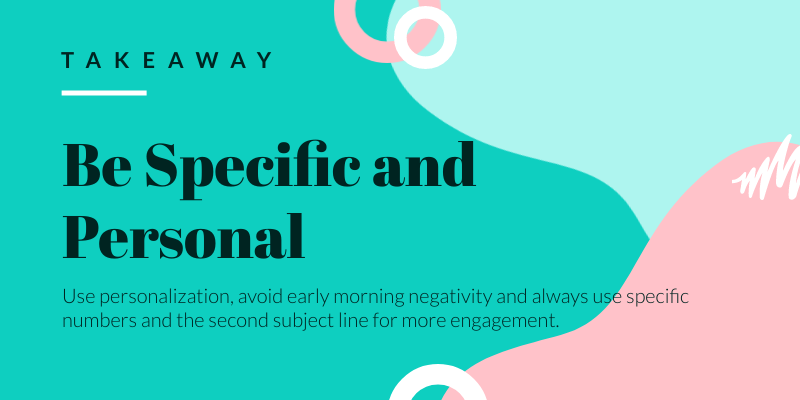
Five Tips For More Clicks
Get More Clicks Using These 5 Tips
- Use captions on your images. People read them so you should be writing them!
- Add a “Press Play” button on your images (that link to a video). Don’t forget the caption. This significantly increases the click-through rate.
- Use animated flash banners to attract attention to your Call To Actions (CTA’s). Movement attracts eyeballs (and clicks).
- Video in email?!? Use gifs to create a preview of your videos in your emails. Link the gif to the video and see your click-through rates improve overnight.
- Ask questions in a survey format. Make sure your audience isn’t sure what the correct answer is, but they would definitely like to know. Make them click through to find out the answer.

Chapter 4: Email Marketing Campaigns
In this chapter we’ll cover the profitable types of emails you can send to your list.
I’m going to show you how to accelerate the customer journey with email marketing templates.
Starting with five (5) types of campaigns every email marketer needs for success.
Let’s go.
Email Marketing Campaign Types
There are five (5) different types of email campaigns that email marketers should be using:
1) Indoctrinate
2) Engage
3) Ascend
4) Segment
5) Re-Engage
I’ll cover each one and explain what, how, and when to use each email campaign type.
Keep in mind, all of these campaigns, besides the segmentation campaign, are automated and triggered by specific actions.
Let’s get started.
#1 Indoctrination Campaigns
Indoctrination (or introduction) campaigns are your first automated follow-up emails sent immediately after an initial subscription.
These are automated emails triggered after a new subscriber joins my list.
The GOAL is to engender your brand and engage new subscribers with something compelling and useful.
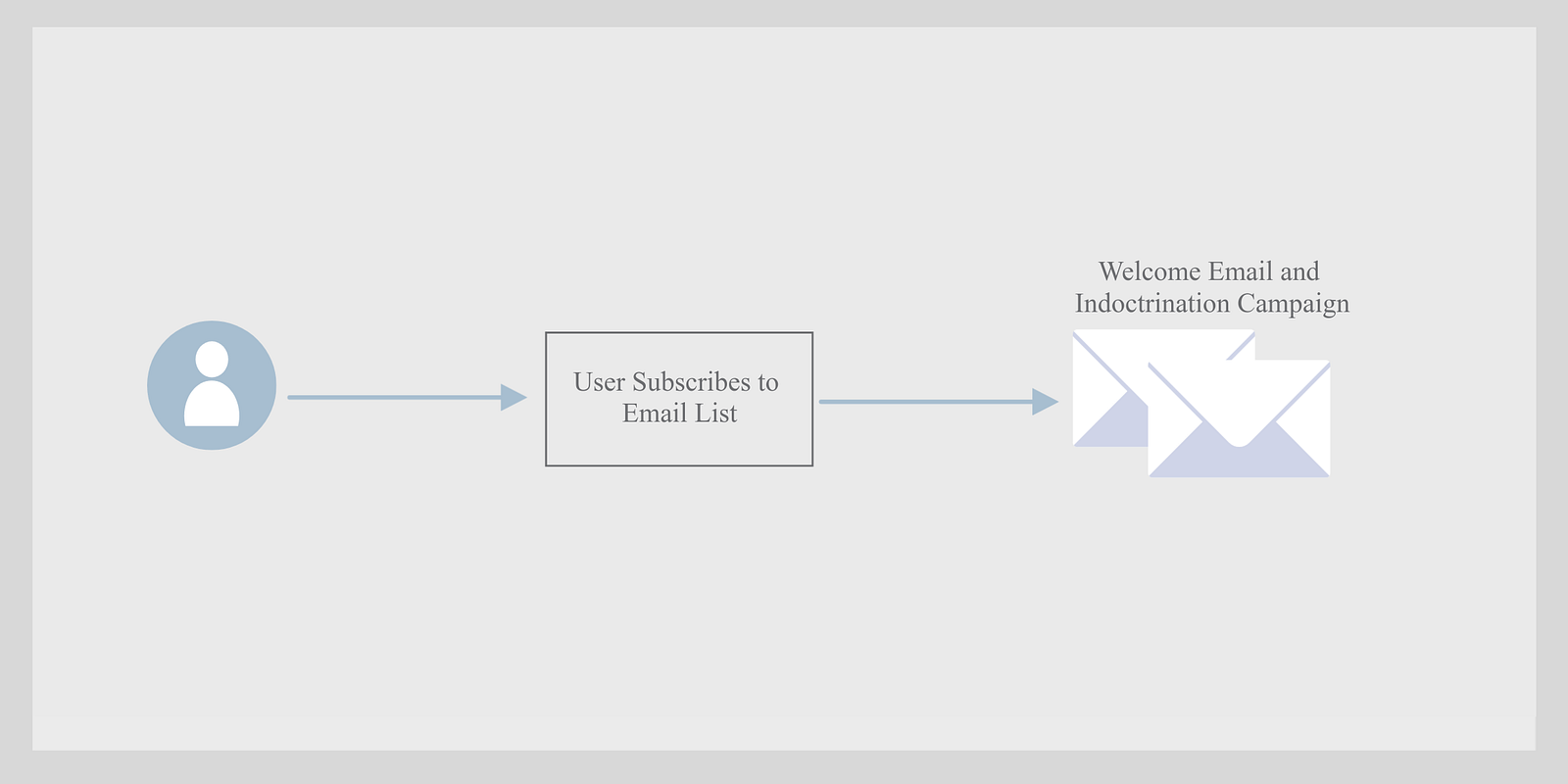
Make them happy they’ve signed up.
Here’s how an indoctrination campaign might look.

Anatomy of a welcome email

Here’s an example from our Hotel Headline Indoctrination campaign…

Email one in the series did pretty well with nearly a 40% open rate.
Let’s see how the second email in the campaign performed.
Here’s email #2

The campaign’s second email did even better.
It’s not surprising.
There was a lot of value in the email.
But more importantly, they were expecting this email. I told them in the first email to expect and look forward to my next email tomorrow.
Here’s what the stats looked like for email #2.

Here’s another example, this one is from Zapier‘s welcome email.

After clicking through on the weather zap I’m sent to a free signup page with a nice call to action.
They now know that is something I’d like to automate with their service.
Clicking the “Weather Zap” might also indicate I am a casual user.
As opposed to the other Zap using Slack which would, likely, indicate business use.
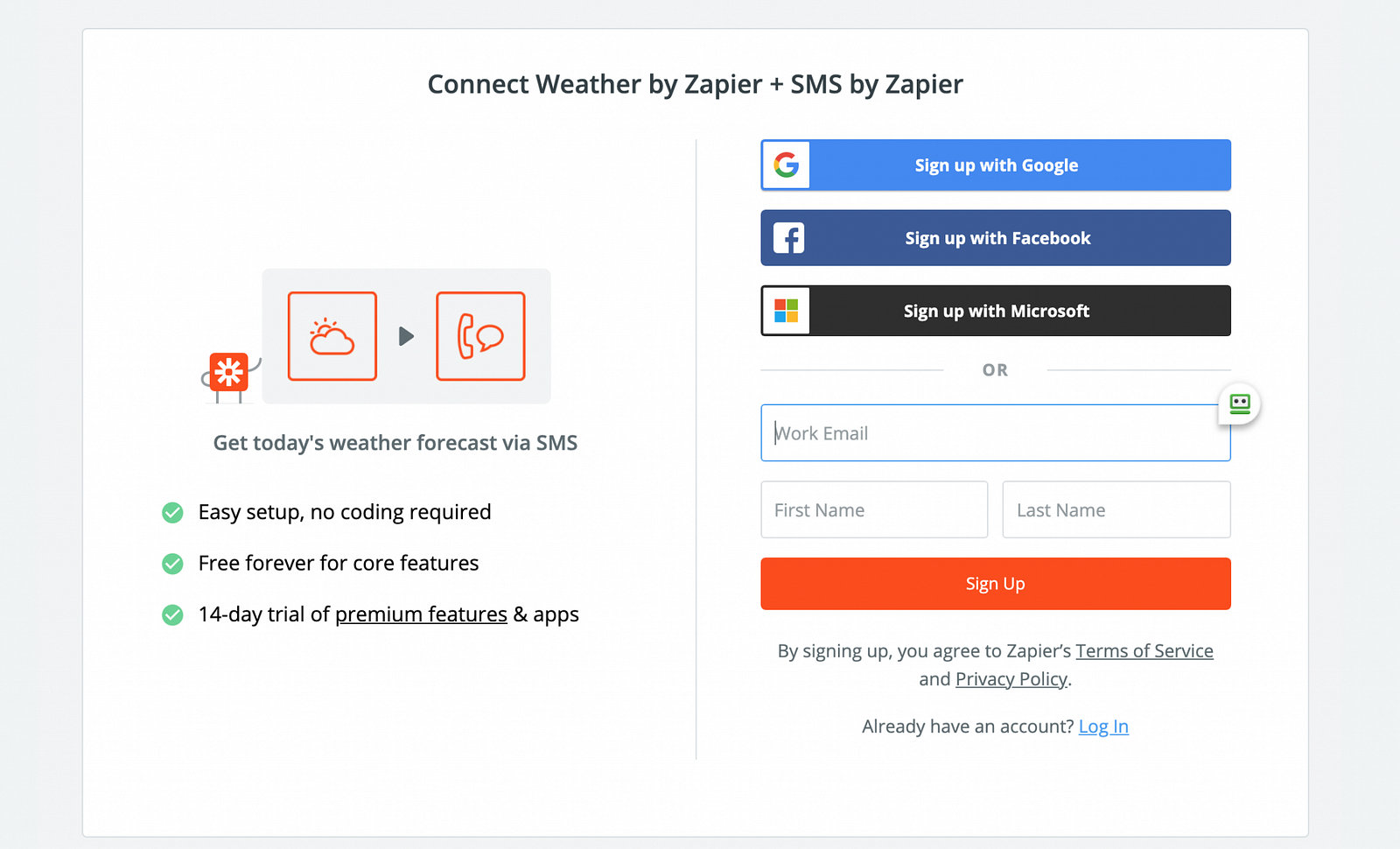

#2 Engagement Campaigns
An interest-based triggered email campaign is sent immediately following an action.
The GOAL is to make a relevant offer (and/or sale) to your subscriber.
Most email marketing software allows you to trigger email campaigns based on user actions like opening an email or clicking a link.
For example, if a subscriber clicked this link in an email: “The Definitive Email Marketing Guide” we’d know that was an interest of theirs.
When we set up the link we make sure that anyone that clicks it is tagged with something like “Interest: Email Marketing”.
From there we could trigger an engagement campaign to send them a highly relevant piece of content or a low dollar offer to initiate a sale.

Engagement campaigns laser focus email marketing messages.
An engagement campaign could look something like this…

Going back to the welcome email from Zapier.

If I were to click the Slack integration, indicating business use, I’d trigger an email like this from Zapier.

Clicking the Call to Action sends me to this page.

They offer me value in advance and an opportunity to try their service for free.
Engagement campaigns:
- Turn subscribers into conversions (define a conversion)
- Reference previous POSITIVE brand interactions (always do this)
- Overcomes (or safeguards against) known objections
- Prescribes the next logical step for subscribers and guests

After a free trial or a low-dollar conversion, it’s time to trigger our next campaign.
Elevating single buyers into multi-buyers.
Here’s how.
#3 Ascension Campaigns
Are triggered campaign emails sent immediately following the purchase to start the “Value Loop” designed to turn ordinary buyers into multi-purchasers.

When storyboarding and ascension campaign, ask yourself:
- What is the next step I want them to take?
- Do I have a reason to believe they’re ready to take the next step?
- Do I have anything else I can sell them?

#4 Segmentation Campaigns
Manual email campaigns are sent to your entire database as a promotion.
The GOAL is to segment subscribers by interest.

Methods of segmentation:
- Use content
- Use special offers
- Use events
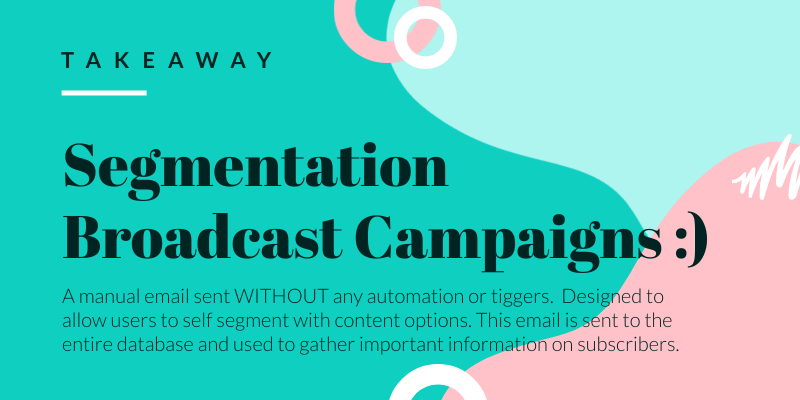
#5 Re-engagement Campaigns
A triggered campaign that is sent only to subscribers who have not opened or clicked an email in the last 30–60 days.

The GOAL is to re-engage the subscriber with your brand.

Chapter 5: The Three Email Types
In this chapter, we cover the three types of emails email marketers can leverage.
I’ll show you how to classify these emails and use them to expedite the customer journey.
Here we go.
The Three Email Types
There are three (3) types of emails that move guests down the path to purchase:
- Transactional
- Relational
- Promotional
I’m going to show you exactly what these emails are and how to use them to maximum advantage. For example, transactional emails generate 2x-5x more revenue than other types. (Experian)

#1 Transactional Emails
These types of emails can be used to expedite the customer journey.
Transactional emails are things like order confirmations, purchase receipts and account creation emails.
Of all email types, transactional emails have the highest open rate.
Don’t get greedy with these but do use them as a way to make more money.
I use transactional emails to make relevant upsell or down-sell offers to my customers. The offer has to be relevant, logical and time-sensitive to get the best results.

#2 Relational Emails
Any email you send that follows through on a promise to the subscriber.
Examples are new subscriber welcome, lead magnet emails and coupon delivery.
Relational emails complete the promise.
These are relationship-building emails that let subscribers know you will follow through on your promises to them.
So what’s that mean? It means these emails serve a signal to subscribers that you’re honest, helpful and humble. Relational emails show my subscribers that I’m going to follow through on my promises and continue to offer them value.
That makes sense, right?
I want you to think of an email you love getting. Then think of “why” you love getting it.

#3 Promotional Emails
Marketing emails that move subscribers from non-buyers to buyers.
They can be used to transform single buyers into multi-buyers.
Promotional emails are direct calls to action. Whether that action is a new lead, a referral, or a straight-up sale depends on my marketing goals.
This is the bread and butter for email marketers when it comes to first-time AND repeat sales. Use promotional emails to test your offers, get sales and boost event signups. Think of these as the email version of a billboard.

*Pro Tip: Promotions are a great way to segment your list. Send a couple of different promotions and see who, on your list, clicks what (and buys). Send them more of what they want in the future.

Defining Success by Email Type
Peter Drucker said, “What gets measured gets managed.”
I agree.
To ensure I’m getting the most mileage out of my marketing I define success for each email type upfront.
Here’s what to expect and measure from each email type.

Transactional Emails
- Customer Service/Satisfaction
- Brand Awareness
- Lead Generation
- Loyalty and Referral
Relational Emails
- Engagement
- Nurturing
Promotional Emails
- Sales
- Upsells
- Cross-Sells

Chapter 6: Planning Promos For Max Profit
To get the most out of email marketing it pays to plan promotions.
Here’s how we help our members get the most profit from their email marketing without wasting a lot of time.
Let’s plan some campaigns for maximum profitability.
Two Vital Planning Assets
There are two basic assets that inform your entire email marketing strategy.
They are your products (or services) catalog. And your marketing goals and planned promotions.
Pretty obvious, right?

Here’s how I like to start.
I make a list in excel of all the products I have to offer.
I then organize them by revenue generated all time.
If you have a lot of products or seasonal ones your lookback period would be shorter, say a year.
So, it’s the name of the product, the revenue generated and the number of times you’ve promoted it in a given period.
From here I can see what’s done well, what hasn’t and what I need to promote or schedule.
Now I have the list.
The next thing I do is create a promotional cheat sheet for the next 12 months. I want to slot in the products and promotions that meet my marketing goals.
Then for each promotion, I fill out a form like this one below.
Promotional Planning
Promotional emails are the profit centers for email marketers.
They’re important.
It makes sense to plan each promotion. Aligning them with your overall marketing strategy.

Using a promotional planning sheet for email marketing simplifies, clarifies, and focuses marketing strategy.
Here are twelve (12) steps you can use for better promotional planning:
- Start with a 12-month revenue goal
- List non-revenue goals
- Slot holiday promos in the appropriate month
- Slot annual promos in the appropriate month
- Factor in seasonality
- Slot non-revenue goals in the appropriate month
- Breakout revenue goals monthly
- Add revenue projections
- Subtract “expected” from “target” and fill in the remaining revenue needed.
- Brainstorm additional promo ideas (list in potential promos — going back to step 1)
- Check, monitor, and adjust
- List additional needs
Focus on the next 30–90 days.
Go further out to get your footing and have general plans for the future.
No strategy survives contact with the enemy.
Planning promotions gives email marketers time to strategize, orient, adapt and overcome obstacles in their chosen market.

Chapter 7: Email Headline Formulas
What good is a great email if no one opens it?
Famed copywriters, like Eugene Schwartz, would spend up to a week writing a headline. Crafting it for maximum effect.
Luckily, I’ve distilled that process down into easy-to-use templates and formulas.
A good subject line (headline) will ensure your emails get the open rates the content inside deserves.
Let’s get (even) more opens.
Why Are Email Subject Lines Important?
I want my subscribers to open my email.
It’s my first success metric when I use email marketing. The percentage of opens (or open rate). The best way to do this is with a great subject line.
That’s not to say a simple headline won’t work.
It does.
“Email Marketing Ultimate Guide”
and
“How I get a 3,880% marketing ROI”
Above, are both decent subject lines in their own right. One is more simple than the other, clearly. As we go through the formulas, remember simple does work.
To get a baseline, here are the average open rates from a recent study. (Kinsta)

They further break this data down by industry-level here.

No matter what the industry, open rates average around 20%, with a few outliers.
One way I improve open rates is with the right subject line.
Let’s take a look.
What’s The Ideal Subject Line Length?
What’s the right length for a subject line?
Like all things digital marketing, there’s an answer, but it is somewhat open for interpretation.
According to Marketo, this is what they’ve found. (Marketo)

Here’s a simpler explanation from the same source.

If the goal is to get more opens it seems shorter is better when it comes to subject lines.
Types of Email Subject Lines
There are three types of headline formulas I use to get more opens.
They’re motivated by human psychology and made more effective because of that. The three types of email subject lines I use are:
- Gain Headlines
- Social Proof Headlines
- Fear or Threatening Headlines
Let’s get started with the first in the list, gain headlines.
#1 Gain Headlines:
Headlines focusing on benefit(s) to your subscribers. Gain headlines emphasize what they’ll (your subscriber) be getting out of the bargain.
Gain formulas I use:
- The Secret to [Desired Result] Is Revealed
- Where [Desired Result] Is and How to Get It
- Discover the [Desired Result] Secret
- You, a [Desired Result]
- Get [Desired Result] Without [Undesired Result]
#2 Social Proof Headlines:
Your subscribers want to know that they’re making the right decision by opening your email. Social proof is a smart way to get more opens and engagement for your email marketing messages.
Social proof formulas I use:
- Here Is a Method That Is Helping [World-Class Example] to [Blank]
- Savvy/Smart/Sexy People Do [Blank]
- Why I [Blank] (and Maybe You Should Too)
- Why [Impressive Number] of People are [Taking Desired Action]
- A Simple Way to [Desired Result] That Works for [Desired Group/Person]
#3 Fear or Threatening Headlines:
No one wants to miss out. Creating a sense of urgency or stoking a fear of missing out is an effective strategy. The offer must actually be urgent, timebound or limited to generate results AND please your subscribers.
Fear or threatening formulas I use:
- The Biggest Lie in [Your Industry]
- The [Blank] Risk Hiding in Your [Blank]
- [X] Shocking Mistakes Killing Your [Blank]
- [Blank] May Be Dangerous to [Something Precious]
- Don’t Try [Blank] Without [Desired Action] First

Chapter 8: Advanced Email Marketing
A little technical “know-how” can go a long way for your marketing efforts.
In this chapter, I’ll explore some of the more advanced email strategies.
I’ll show you how to improve your “sender score” and make sure your marketing messages end up in your subscriber’s inbox.
Ready? Let’s get it.
Email Marketing Self Analysis
Let’s start with a quick audit and answer some questions about our email list.
Here are five good questions to get a baseline.
- How big is your email list?
- Are you emailing your entire list?
- How many people open your emails? (open-rate)
- How many clicks? (click-through and open-to-click)
- How many unsubscribe and/mark SPAM?
The following steps help me better benchmark my email marketing performance. Give them a spin with your own email list.
Five steps for better benchmarking:
- Do a look-back & chart every broadcast for the last 3, 6, 12 months.
- Establish averages for opens, clicks, unsubscribes, complaints, forwards, etc.
- Find and Identify irregularities…any breakouts good or bad?
- Look for real patterns. (Topics, Dates, Times, From, etc.)
- Baseline goals & numbers for everything. (green/red/yellow)
Establishing and Monitoring Email Key Performance Indicators (KPI’s)
Using a simple excel sheet I track the following performance indicators. These stats let me optimize, assess and understand my email marketing performance.
Setting up a schedule to review and spot check weekly or bi-weekly, to look for early indicators of success or failure, makes improving easy (or easier).
Here are a few things you’ll want to look at weekly:
- Check Opens, Clicks, Unsubscribes & Complaints
- Deep Dive & Correct Monthly (look for emerging trends good or bad)
- Check Time, Topic, and Email Types
Better Deliverability
Believe it or not, a majority of emails never reach the inbox.
Many aren’t delivered, sent to SPAM, or blocked by filters. To avoid this trap I take extra steps to PROVE I’m not a SPAMMER. Not only that, I want to be in their inbox, instead of the “Promotions” tab.
Here’s how to do it.
1) Foster Mailer Reputation
I want my emails to reach my subscribers.
To do so I need to keep an eye on my mailer reputation.
So what impacts mailer reputation?
A) First is your message volume and consistency
If I’m sending gazillions of emails to subscribers they need to be opening them. If they don’t my reputation is going to take a ding.
What about emailing my list infrequently?
Turns out that’s a bad idea for your reputation too.
I try to be consistent with my emails. I balance that by not drenching my subscribers with too many messages.
My email reputation is going to go up if I am sending regular emails to subscribers that open them. Makes sense, right?
Next up.
B) Delivery rate
This is the number of subscribers your email marketing reaches. Now, it doesn’t mean they opened it. It only means that the email reached its destination. Their mailbox.
Think of it as when the mailman puts the mail in your box. It’s there. Where it should be. Now, it’s up to you to open it.
Why wouldn’t my emails get delivered?
If my emails don’t get delivered it’s going to be a hard or soft bounce.
What’s an email bounce? Sounds fun!
It isn’t.
Here’s a nice little definition from Active Campaign
“A bounced email, or bounce, is an email message that gets rejected by a mail server. When an email bounces, it has for some reason not reached the intended destination.”
There are two types of bounces like we said. (Active Campaign)
Hard Bounces:
“A hard bounce is an email that cannot be delivered because of a permanent issue. Common reasons for hard bounces are typos, domains that do not exist, or email addresses that don’t exist. Hard bounces negatively impact your sending reputation and deliverability and should be corrected as fast as possible.”
Soft Bounces:
“A soft bounce is an email that cannot be delivered due to a temporary issue. Reasons for a soft email bounce include full inboxes, emails that are too large to send, or a temporary email suspension.”
What’s the difference?
Soft bounces are temporary. Hard bounces are permanent.
Robert@Yahooo.com is going to be a hard bounce. There’s an extra “o” in Yahoo. That’s not going anywhere.
“Mailbox Temporarily Full” is going to be a soft bounce. They need to delete some emails then they’ll be able to get messages.
C) Don’t get blacklisted.
Break too many rules and you’ll end up blacklisted. SPAM complaints, poor deliverability, and crappy emails can land you on the naughty list.
How can you know if you’re blacklisted? That’s the easy part 🙂
Head over to MXToolBox and run their blacklist check on your domain. Easy. Are you blacklisted? Probably not, but it’s good to check.

2) Sender Infrastructure
Have your hard hats ready. Let’s check on my email infrastructure.
A) First up is my Sender Policy Framework (SPF).
Sounds technical, right? It is.
This framework authenticates a website or domain’s IP address and web address. It makes sure that the IP sending the email comes from the same domain.
“The Sender Policy Framework (SPF), is a technical standard and email authentication technique that helps protect email senders and recipients from spam, spoofing, and phishing.”
Here’s how an SPF works
- A domain administrator publishes the policy defining mail servers that are authorized to send emails from that domain. This policy is called an SPF record, and it is listed as part of the domain’s overall DNS records.
- When an inbound mail server receives an incoming email, it looks up the rules for the bounce (Return-Path) domain in DNS. The inbound server then compares the IP address of the mail sender with the authorized IP addresses defined in the SPF record.
- The receiving mail server then uses the rules specified in the sending domain’s SPF record to decide whether to accept, reject, or otherwise flag the email message.
B) Sender ID.
Use this to validate the origin of your emails and pair them to your domain. Here’s how Microsoft describes it.
Sender ID is used to detect spoofing.
“A spoofed email message is modified to appear as if it originates from a sender other than the actual sender of the message. In the past, it was relatively easy to send spoofed email messages, because the sender’s email address in the message header wasn’t validated. Sender ID uses the RECEIVED SMTP header and a query to the DNS records for the sender’s domain to determine if the sender’s email address is spoofed.”
C) DKIM.
Exciting, another authentication method.
A DKIM is a way to digitally sign a sending domain to ensure validity.
“DomainKeys Identified Mail (DKIM) lets an organization take responsibility for a message that is in transit. The organization is a handler of the message, either as its originator or as an intermediary. Their reputation is the basis for evaluating whether to trust the message for further handling, such as delivery.” (DKIM.org)
It’s all very technical, but a quick Google search can get this done for you. At the end of the day these methods need you to do some light copying and pasting of records. Talk with your host. Chances are they’re already doing it or will assist you.
3) Subscriber Engagement
I want my subscribers to be into what I’m sending them. If they’re “not that into you” then it’s going to show in your engagement stats. Lowering your sender reputation over time.
How do I measure subscriber engagement?
I start with deliverability. We covered it above. If I have hard bounces on my list they need to get off. Delete useless emails with a vengeance. What’s a useless email? One that doesn’t get delivered. Get rid of those first.
Then move onto this.
Open-Rate: This is the percentage of email recipients that open the email. Send 100 emails and 20 people open that’s a 20% Open-Rate. If this is hitting anything under 9% it can hurt your sender reputation. Use strategies in this guide to improve open rates and re-engage subscribers.
Archive or delete people that don’t open your emails. I put them in a last chance re-engagement campaign and call it a day. If they don’t open an email they get unsubscribed.
Bringing us to our next engagement metric that impacts sender reputation.
Unsubscribe and complaint rate
Unsubscribes are OK. You want to get rid of people that don’t want you. If it’s excessive you have a problem. A few here and there are alright.
Complaints are bad. This is when someone clicks “Mark as SPAM” on your email. Get enough of these and your reputation is going to decline fast. Avoid it with great content and good email list hygiene.
Chapter 9: Bonus Resources
Not all email marketing software is created equally.
In this bonus chapter, I’ll compare, evaluate and recommend some of our favorite digital marketing and email tools.
Let’s dive in.
Email Service Providers
To send marketing emails I need an ESP (Email Service Provider). There’s a lot of options out there. We’re going to cover and compare our favorites.
Let’s start with Moosend. Never heard of it? Here’s why I think it’s worth your time to check out.
#1 Moosend
Why we like it:
- Free to try (no credit card required)
- Intuitive designs
- Easy to navigate
- Fun to setup
- A gazillion templates
- Advanced email features
- Superb automation
- Affordable

Moosend is one of the youngest and most eye-catching email marketing automation tools and offers a generous free plan.
With Moosend, you can create responsive email newsletters, automate your marketing campaigns, and expand your mailing list. When it comes to Moosend’s drag-and-drop email builder, you can effortlessly create stunning responsive email campaigns by adding advanced features like timers, videos, GIFs, and more.
Moosend Features
- Free email newsletter templates you can fully customize
- Advanced marketing automation to create tailored content
- Email list segmentation to nail your email list management
- Landing page builder to boost your conversions
- Subscription forms to capture more leads
- Integrations to streamline your business tasks
- Real-time reporting and analytics to monitor performance
Moosend Pricing
You can get Moosend for free. Get a free account here. Paid plans start at $8/month. That’s a great price. Compared to Constant Contact that’s 60% cheaper.
#2 ConvertKit
ConvertKit is the new kid on the block. Created in 2013, ConvertKit primarily serves creators and small businesses. With a strong focus on the creator community, it’s ideal for YouTubers, Bloggers and Affiliate Marketers.
Even though it’s relatively new, ConvertKit continues to release new and useful features.

ConvertKit Features
- Customizable call-to-action buttons
- Template management to have everything in order
- Event-triggered emails to win your crowd over
- Various email types including autoresponders
- Easy-to-customize opt-in forms (popups, floating boxes, etc.)
ConvertKit Pricing
ConvertKit has a totally free plan for up to 1,000 subscribers, with limited features though. Pricing starts at $29/month for up to 1,000 subscribers providing access to automated funnels and sequences, while features like lead scoring and advanced reporting can be found in the top-tier plan.
#3 GetResponse
GetResponse is an affordable and feature-packed option to start email marketing and plan your next email campaign. You can get a wide variety of optimization tools that you’ll find user-friendly and allow you to customize everything that comes with your brand.
Furthermore, GetResponse can help you increase traffic and boost conversions in an easy, intuitive manner through its complex automated series and email tracking options. Email list management is also possible, allowing you to automate your contact management efforts.
Overall, GetResponse offers a great email marketing tool with great segmentation features, geo-tracking, and integrations. Nevertheless, its email deliverability could be improved.

GetResponse Features
- Web forms that allow you to focus on customizing
- Spam email tools to avoid the spam folder
- A/B Testing and Analytics for your landing pages
- Autoresponder tool that will help you focus on your tasks
- Integration with popular services (Shopify, Salesforce, etc)
GetResponse Pricing
GetResponse doesn’t offer a free plan. It does have a 30-day free trial.
Pricing starts at $15 a month, and it can support up to 1K subscribers for the Basic plan.
Now it’s your turn!
You’ve got the facts, and they are facts well known to all successful marketers. Armed with this knowledge it’s time to take your email marketing efforts to new highs.
Whether you’re just getting started with email marketing or are a seasoned pro I hope you found this information helpful.
What will you do next?

About the author:
Robert McMillin is a digital marketer and CEO of GrowDirectBookings.com and McMillin Digital L.L.C. He’s been helping businesses large and small increase digital revenues for over 10 years. Get in touch with him at Robert@GrowDirectBookings.com.

